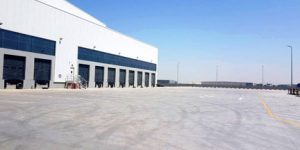SFRC FLOORING

Steel fibre reinforced floor is defined as a floor made of concrete, containing discontinuous discrete steel fibres. Steel fibres are incorporated in floor concrete to improve its crack resistance, ductility, energy absorption and impact resistance characteristics.
Properly designed and dosed SFRC floor can reduce or even eliminate cracking a common cause for concern in plain concrete.
A benefit of jointless floors to the building user is the opportunity of having relatively large areas of floor with no joints. However, the formed free-movement joints at the edges of each area will be wider than in floors with multiple sawn joints and will typically open by 20 mm.
Jointless concrete floors, reinforced with steel fibers are modern high-quality alternatives to traditional concrete floors with saw cut joints. Usually about a jointless floor we talk when the distance between joints is at least 12 m and under certain conditions it can reach 45-50 m. In practice, this means that it is possible to lay a concrete floor with an area up to 2500 m2 without saw cut joints!
When making jointless floors the fields are limited and shaped using factory produced special profiles for dilatation joints with dowels installed and integrated protection of the edges of the joint. The dowels contribute to the load transfer between the two neighbouring fields and allow opening of the joint due to shrinkage or temperature differences up to 30 mm.
By replacing traditional welded mesh reinforcement with high-end structural steel fibers the loading bearing capacity of the floor increases significantly thus achieving greater control over the cracks. It is possible to make a jointless field of large bay areas because the steel fibers “bridge” the cracks that form in the concrete and prevent their further “opening” into larger cracks.
Advantages of Jointless SFRC Floor
- Less floor thickness compared with that of floors with conventional reinforcement due to the ability of fiber to accept plastic loads
- Reducing the length of joints up to 75%
- Decreased curling of the floor, which means: lower maintenance costs of servicing warehouse equipment (forklift trucks, reach tracks, VNA machines, etc.). higher speed of service equipment,higher productivity of the warehouse activities
- Reduced health complaints from drivers of the servicing warehouse equipment
- Aesthetic appearance on the floor
- Increased dynamic strength and impact resistance
- Less damage to edges and corners.
- Racking and equipment is able to be placed anywhere on the floor – no joint considerations
- Reducing the opportunities for compromise joints and related activities for repairing which means lower maintenance costs on the floor.
- Superb fatigue and endurance
- Shrinkage and crack control
- Increased tensile, compression, shear flexural strength
- High impact strength
- Faster construction of floors
